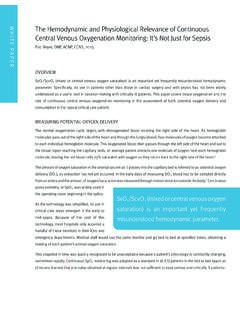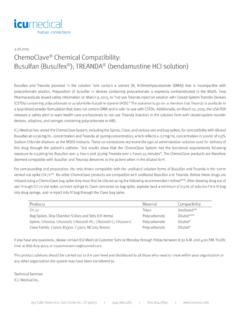Transcription of Integration of Smart Infusion Pumps with Electronic ...
1 Integration of Smart Infusion Pumps with Electronic WHITE PAPER. Medical Record Reduces Potentially Catastrophic Medication Dosing Errors King V., MS, BSN, Hum D., RPh, Kendzierski D., PharmD, Arvelo C., MBA, BSN, Overdyk , MSEE, MD. Abstract BACKGROUND. Smart ' Infusion Pumps with built-in dose error reduction software (DERS) containing hard and soft limits on prescribing ranges have, in retrospect, been found to eliminate only some of the medication errors associated with intravenous In order to optimize five rights compliance, a greater level of Smart pump Integration enabling error checking and redundancy at all the contact points in the workflow is required. Intravenous automated programming (IVAP) that enables the physician order, medication, and patient to be verified via barcode scanning at the point of care requires clinical Integration of Infusion devices with the EMR (CIDER).
2 OBJECTIVE. The purpose of this study was to determine the impact of CIDER on reducing serious, preventable medication errors, as classified by The National Coordinating Council for Medication Error Reporting and Prevention (NCC MERP) Medication Error Index. Furthermore, we were interested in the impact of CIDER in increasing drug library compliance and reducing variability of practice in programming Infusion Pumps . CASE STUDY. From January 2013 to February 2014, there were 512,636 programming sequences recorded across three hospitals, 224,763 (44%) during the pre- Integration period and 287,873 (56%) during the post- Integration period. CONCLUSION 2. The incidence of potentially catastrophic dosing errors (PCDEs) across the combined group of three hospitals decreased after CIDER by 52%, from errors per 1000 programs to per 1000 programs, P< (Table 1).
3 Increase in compliance with drug library was 156% between the pre- and post- Integration periods for the combined group of three hospitals from 20% to 51%, P< (Table 2). Analysis over time shows a clear pivot in both results corresponding to CIDER go-live and is sustained after Integration . Variability in the severity of individual PCDEs also displayed a large and statistically significant reduction. All three of these metrics improved at each hospital. Introduction Medication errors associated with intravenous Infusion remain a serious threat to patient safety in spite of numerous interventions to reduce their incidence. In order to assure patients receive the right drug in the correct dose by the intended route for the appropriate period of time, a greater level of Integration of the Infusion device with its environment is needed.
4 Safer Infusion therapy demands error checking and redundancy at all the contact points in the workflow, starting with the physician's order in the Electronic medical record (EMR) to the pharmacy where the drug is compounded, converging at the point of care where the provider administers the drug via the device. Intravenous automated programming (IVAP) allows the Smart ' Infusion Pumps with built-in dose error reduction physician order, medication, and patient to be verified software (DERS) containing hard and soft limits on via barcode scanning at the point of care and requires prescribing ranges have, in retrospect, been found to clinical Integration of Infusion devices with the EMR. eliminate only some of the medication (CIDER).
5 Although CIDER can be initially complex and requires resources to support, healthcare facilities agree that it improves patient safety by eliminating the potential for human error and encourages drug library compliance, the use of barcode medication administration (BCMA) systems, and the standardization of nurse In this study, our primary outcome of interest was the impact of CIDER on reducing serious, preventable medication errors, as classified by The National Coordinating Council for Medication Error Reporting and Prevention (NCC MERP) Medication Error Index. 4. Furthermore, we were interested in the impact of CIDER in increasing drug library compliance and reducing variability of practice in programming Infusion Pumps .
6 Methods This study took place at three community hospitals with approximately 50, 150, and 350 beds where a Cerner Millennium EMR was integrated with ICU Medical Plum A+TM Infusion Pumps (Model #20792, hospira MedNetTM safety software rev ) from January 1, 2013 to February 1, 2014. and was restricted to the following clinical areas: Cardiovascular ICU, ICU, Neuro Critical Care, MedSurg, Obstetrics, Oncology, and Progressive Care Unit (PCU). We retrospectively analyzed Infusion pump programming records before and after Integration of Infusion Pumps with the EMR to measure the impact of CIDER on the incidence of PCDEs. We defined PCDEs as initial programmed doses/. rates of intravenous medications considered high alert' medications5 by the Institute of Safe Medication Practices (ISMP) that were either 100% greater than or 50% less than the final programmed doses/rates.
7 We hypothesized that these errors were likely to cause patient harm or require medical intervention to preclude harm if undetected. As such, the NCC MERP Medication Error Index would classify these events as D' through I'. 4 As a secondary outcome, we chose to measure pre- and post- Integration compliance with the use of the drug library (as an opt-in step) when programming the Plum A+ Infusion pump. hospira MedNet safety software includes a drug library, which was custom-built for each clinical care area (CCA) and standardized as a single drug library across all three of the hospitals studied. Use of a DERS. has been shown to reduce medication errors and improve patient If the provider did not choose to opt in to hospira MedNet when manually programming the Plum A+, that action was deemed noncompliant.
8 The workflow during the study was as follows. During the pre- Integration period, the provider retrieved the physician's medication order from the Electronic medication administration record (eMAR) and programmed the Infusion pump manually, including patient weight, drug, dose, rate, and volume to be infused at the point of care. Compliance with hospira MedNet safety software was counted when the provider selected a medication from the drug list for that Infusion . Subsequent programs for that Infusion , such as titrations, were also counted as compliant with hospira MedNet. If the provider bypassed the drug list, that Infusion and subsequent titrations would be noncompliant with hospira MedNet. Post- Integration , the provider ensures the five rights verification (right patient, medication, dose, time, and route) by signing into the eMAR, and by scanning the barcode on the patient, medication, and appropriate pump channel (primary or secondary).
9 The completed order is displayed on the pump and the provider confirms and starts the Infusion . (Figure 1). This study took place at 50. 3. EGRATED. 150. NT. with . I. APPROX. WHERE A. 350. W IT H. community hospitals BEDS each Cerner Millenium EMR. hospira Plum A+TM. Infusion Pumps Smart Pump-EMR Integration Workflow Overview Figure 1. Clinical workflow in Smart pump-EMR integrated environment This workflow allows the physician order detail, including the fluid/medication and concentration, dose/rate, and volume to be infused (VTBI) to flow from the CPOE through the pharmacy verification process, and on to the point of care where it is automatically programmed on the pump via the barcode scanning process. The drug library alignment process is collaborative and involves the pump vendor (ICU Medical), the EMR vendor (Cerner), and the hospital pharmacy team.
10 Depending on the degree of alignment required and the availability of resources, it typically takes three to five months and includes several rounds of testing, including connectivity and communication between the EMR system and ICU Medical Infusion Pumps . Prior to the go-live date, a clinical readiness and impact assessment All unique hospira MedNet drug of IV therapy clinical nursing and pharmacy practice conducted by ICU library entries are tested prior to Medical Clinical Services identifies variations in clinical practice, as well as go live to ensure optimization of the opportunities for standardization of Infusion therapy workflow. Integration through verification of The goal of the assessment is to increase quality of care by reducing required workflows and accuracy of variability in Infusion therapy clinical practice.












